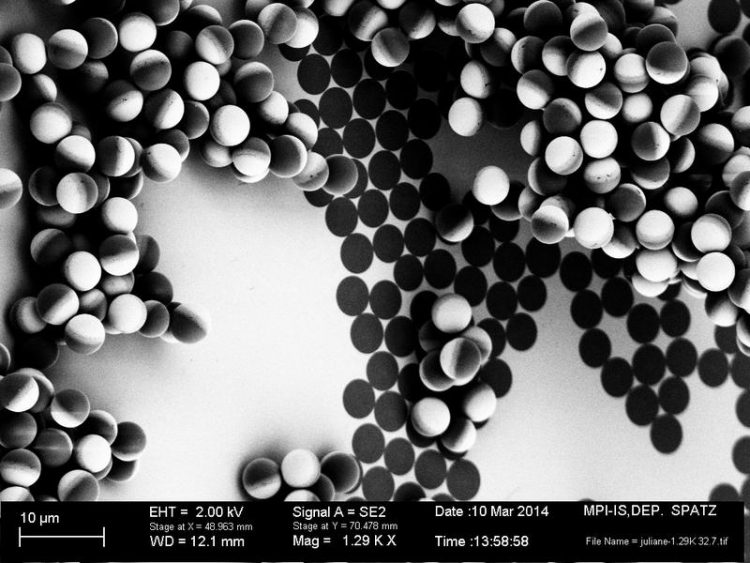Micromotors to open new horizons

Electron microscope image of nanoscale Janus particles, which the Freigeist-group is going to test regarding their capacity as photocatalytic nanomotors. Juliane Simmchen
The team will be researching a new kind of energy input for micromotors – fascinating novel devices bearing great potential for future technology.
A ‘Freigeist’ fellow: for the Volkswagen Foundation this means a young researcher with a strong personality, a creative mind, an ability to identify and use freedom, dedicated to overcoming resistance. Dr. Juliane Simmchen of TU Dresden is one of these extraordinary researchers who wants to overcome existing disciplinary boundaries to gain innovative insights.
During her doctoral thesis in Barcelona/Madrid and as a postdoc at the MPI in Stuttgart, she had been researching catalytic micromotors – a fascinating new field in the movement at the microscale connecting several disciplines of modern science. Micro- and nanomotors are novel devices which can transform energy into movement. Unlike large scale engines dominated by inertia, however, the movement of objects at the microscale requires a constant energy input.
Collaborating with the group of Prof. Eychmüller, Dr. Simmchen now aims at setting a new course in her work. With photocatalytic reactions on the surface of nanoparticles, the Freigeist group wants to research sunlight driven nanomotors. In combining the two innovative fields of photocatalysts and nanomotors, Dr. Simmchen wants to open new horizons for the use of nanomotors driven by renewable energy in several environmental and analytical applications.
So far, micromotors have been chemically or magnetically driven, often under the use of toxic chemicals. Photocatalytic micromotors, however, could be used for environmental remediation. Not only would using a renewable energy source (namely sunlight) drastically improve the general impact for the environment, sunlight driven micromotors would also increase the mixing and catalytic degradation of organic pollutants. Another potential application lies in novel sensors based on the observation of motion of fluorescently labelled molecules or biological markers. This might pave the way for high sensitivity detection and facilitate the mostly complex sample preparation though self-propelled isolation of the species in focus.
Media inquiries:
Dr. Juliane Simmchen
E-Mail: juliane.simmchen@tu-dresden.de
Media Contact
More Information:
http://www.tu-dresden.de/All latest news from the category: Life Sciences and Chemistry
Articles and reports from the Life Sciences and chemistry area deal with applied and basic research into modern biology, chemistry and human medicine.
Valuable information can be found on a range of life sciences fields including bacteriology, biochemistry, bionics, bioinformatics, biophysics, biotechnology, genetics, geobotany, human biology, marine biology, microbiology, molecular biology, cellular biology, zoology, bioinorganic chemistry, microchemistry and environmental chemistry.
Newest articles

A universal framework for spatial biology
SpatialData is a freely accessible tool to unify and integrate data from different omics technologies accounting for spatial information, which can provide holistic insights into health and disease. Biological processes…

How complex biological processes arise
A $20 million grant from the U.S. National Science Foundation (NSF) will support the establishment and operation of the National Synthesis Center for Emergence in the Molecular and Cellular Sciences (NCEMS) at…

Airborne single-photon lidar system achieves high-resolution 3D imaging
Compact, low-power system opens doors for photon-efficient drone and satellite-based environmental monitoring and mapping. Researchers have developed a compact and lightweight single-photon airborne lidar system that can acquire high-resolution 3D…





















